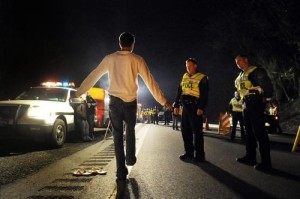Our DWI Lawyers in Albuquerque Explain The One-Leg Stand Test
The one-leg stand test is one of three field sobriety tests that have been “standardized” by the National Highway Traffic Safety Administration.
How the Test Is Supposed to Be Administered
Overview

The officer conducting the one-leg stand test must follow the protocol established by the National Highway Traffic Safety Administration (NHTSA) or the
validity of the test results is compromised. The one leg stand is a “divided attention” test consisting of two stages: an instructions stage and a balance and counting stage. The one-leg stand test requires the suspect to stand on one leg. The other leg is extended in front of the suspect in a stiff-leg manner, with the foot held approximately six inches above and parallel with the ground. The suspect is to stare at the elevated foot and count aloud until told to stop, in this fashion: “one thousand and one, one thousand and two, one thousand and three …”
NHTSA Test Protocol
The officer is instructed to give the test as follows:
- Tell suspect to stand with feet together and arms down at the sides
- Tell suspect maintain that position while you give the instructions; emphasize that suspect should not try to perform the test until you say “begin.”
- Ask suspect if he or she understands.
- Tell suspect that when you say to “begin,” he or she must raise the leg in a stiff-leg manner, and hold the foot approximately six inches off the ground, with the toe pointed forward so that the foot is parallel with the ground.
- Demonstrate the proper one-legged stance.
- Tell suspect that he or she must keep the arms at the sides and must keep looking directly at the elevated foot, while counting in the following fashion: “one thousand and one, one thousand and two, one thousand and three,” and so on until told to stop.
- Ask the suspect if he or she understands.
- Tell the suspect to “begin.”
The officer is also given the following instruction:
It is important that this test last for thirty seconds. You must keep track of the time. If the suspect counts slowly, you will tell him or her to stop when thirty actual seconds have gone by, even if, for example, the suspect has only counted to “one thousand and twenty.”
Scoring the Test
The one leg stand test has four clues of impairment:
- Sways while balancing (side to side or back to front).
- Uses arms to balance (i.e., more than 6 inches).
- Hopping.
- Puts foot down.
Two or more clues classify the subject as a 65% chance of being over a 0.10% blood alcohol concentration (BAC).
Interference and Errors
This test requires a reasonably dry, hard, level, and non-slippery surface. Individuals wearing heels more than two inches high should be given the opportunity to remove their shoes.
Subjects who are over 65 years of age, have back, leg or middle ear problems, or who are over 50 pounds overweight are known to have difficulty with this test.



